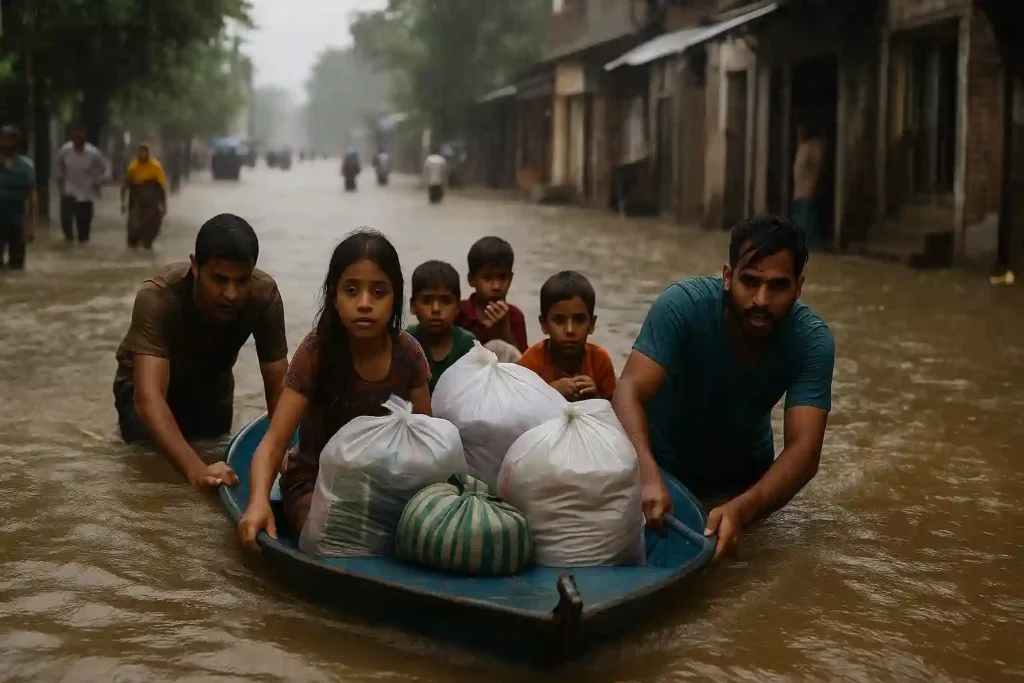
The monsoon has turned killer across South Asia. Over 740 people are dead from catastrophic flooding that has smashed through villages, swallowed entire neighborhoods, and left thousands clinging to rooftops across India and Pakistan.
The death toll climbs by the hour. In Pakistan alone, at least 739 people have been confirmed dead since late June, with the northwestern province of Khyber Pakhtunkhwa bearing the brunt of nature’s fury. In one devastating 48-hour period, flash floods killed 321 people, wiping entire villages off the map.
Mumbai Drowns Again
India’s financial capital collapsed under the weight of water. Mumbai recorded over 500mm of rainfall in just four days between August 16-19, with 300mm falling in a single 24-hour period – more than a third of the city’s average August rainfall compressed into hours of terror.
The city’s pumping stations worked overtime, extracting over 16.4 billion liters of water from flooded streets – more than twice the capacity of Tansa Lake. But it wasn’t enough. At least three people died and two went missing in Mumbai alone, while school buses carrying children got trapped in waist-deep floodwater.
Local trains – Mumbai’s lifeline for 12 million residents – ground to a halt. The newly inaugurated Worli Metro station flooded within hours of torrential rain.
Pakistan’s Villages Vanished
In Pakistan’s mountainous northwest, entire villages in Buner district were obliterated when torrents carrying massive boulders smashed through homes “like explosions”. In the village of Qadar Nagar, 24 members of one family died when floodwaters tore through their home on the eve of a wedding.
“You can say that those who survived have gone mad,” said Aziz Ahmed, a schoolteacher in Buner, describing how the thunder from recent rains was so loud he thought “the end of the world had come”.
The National Disaster Management Authority reported 978 injuries and destruction of over 2,400 houses, with more than 1,000 livestock lost.
In Karachi, Pakistan’s largest city, at least six people died from wall collapses and electrocutions when 145mm of rain triggered urban flooding. The province of Punjab saw extensive flooding along the Indus and Chenab rivers, displacing over 2,300 families and damaging cash crops across thousands of acres.
Human Stories of Terror
“When the rain intensified, it wasn’t long before I felt as if an earthquake had struck,” said Farhad Ali, a student in northern Pakistan. “It felt like doomsday had arrived, with scenes straight out of the end of the world.”
Relief shelters are filling fast across both countries, raising fears of disease outbreaks as families crowd into overcrowded facilities. Rescue teams worked for hours to save 1,300 tourists trapped by flash flooding and landslides in Pakistan’s Siran Valley.
In a cruel irony, a helicopter carrying relief supplies crashed due to bad weather, killing all five people on board.
Official Response: Too Little, Too Late?
Authorities declared states of emergency in nine districts after torrential rains left 368 people dead in just four days.
But angry residents accuse officials of failing them. In Buner, there was no warning broadcast from mosque loudspeakers – a traditional method in remote areas. The government said the sudden downpour was so intense that the deluge struck before residents could be alerted.
Climate Change Amplifies the Carnage
Scientists point to a terrifying new reality. Since the monsoon season began in June, Pakistan has received 50% more rainfall than in the same period last year.
A study by World Weather Attribution found that rainfall was 10-15% heavier because of global warming. The intensity keeps climbing – this year’s monsoon is around 50-60% more intense than last year.
Pakistan remains among the world’s most climate-vulnerable countries, despite contributing only 0.5% of global greenhouse gas emissions. In 2022, floods killed more than 1,700 people and caused an estimated $40 billion in damage.
The Long Road Ahead
As severe weather is forecast to continue into early September, the true scale of this disaster is still unfolding. Crops lie destroyed across Pakistan’s breadbasket provinces, raising fears of food security crises ahead.
For now, survivors wait – for rescue, for shelter, for the rains to stop. But in this new era of climate extremes, the waiting may never end.
Okay, so this is absolutely heartbreaking. The monsoon floods have killed over 1,860 people across India and Pakistan combined this season, with Pakistan alone reporting over 700 deaths since late June. This isn’t just numbers on a page – these are real families being wiped out in minutes.
Here’s my raw take on this disaster:
This is climate change showing its teeth, and we’re still not ready for it. Pakistan’s getting 50% more rainfall than last year, and what’s scary is how fast these disasters are hitting. In some places, 150mm of rain fell in just one hour – that’s like getting six inches dumped on you in 60 minutes. No infrastructure can handle that.
What kills me is reading about 24 people from one family dying in their home on the eve of a wedding. Can you imagine? You’re celebrating, getting ready for the happiest day, and then a wall of water just… takes everything.
The truth nobody wants to say out loud is that we’re building in all the wrong places. Villages on riverbanks, cities in flood zones – and when disaster strikes, it’s always the poorest who pay the price. They can’t afford to live in safer areas, can’t evacuate easily, and their homes get washed away first.
Here’s what needs to happen: Stop building in flood-prone areas. Period. Invest in early warning systems that actually work – not just for governments, but for every village. And honestly? Pakistan produces less than 1% of global emissions but faces the worst impacts. The rich countries causing most of this mess need to step up with real money for climate adaptation, not just empty promises.
This isn’t going away. It’s getting worse every year.
